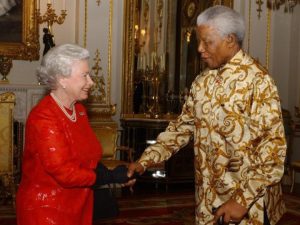
Tyler Fisher, associate professor of modern languages and literatures and Burnett Honors College Faculty Fellow, penned this memory in his journal during his first year living in England to attend Oxford University. He and other Rhodes Scholars met Queen Elizabeth II (and a surprise visitor!) in October 2003.
He reflects on his encounter: “The Queen embodied an unflappable, diplomatic grace, even when I had to admit to her that my dog was named after an arch-villain most famous for attempting regicide.”
October 20, 2003
I travelled to Buckingham Palace by bus on the evening of October 20 to mark the centenary of the Rhodes Scholarships. Five buses departed from Oxford, transporting all Rhodes Scholars currently in residence, their spouses, the staff of the Rhodes Trust and House and their spouses.
The buses stopped at the palace entrance while officials boarded and checked our invitations. I assumed the buses would remain parked there at the palace gates; but we suddenly lurched forward again, the gold and iron gates swung open, and all five buses filed into the palace’s inner courtyard. A crowd of tourists peered after us through the outer gate, wondering, I imagined, how they missed booking a tour on one of those buses.
In hushed awe, we left the buses and followed a red carpet into the palace’s interior, where each room and corridor we passed increased in opulence, until we gathered in the Queen’s art gallery.
Paintings covered the gallery walls: Flemish miniatures, lush landscapes by Turner, Greek deities of Leighton, impressionistic nightscapes — but arranged by no apparent order of date, school, or artist. While I was contemplating the collection, small doors on all sides of the gallery opened and ladies in waiting slipped into the milling crowd. One, Fiona Henderson, attached herself to me. Ms. Henderson was a masterly conversationalist and, after discussing wide-ranging aspects of my first month in Oxford, she informed me that the Queen had been anticipating this event for months, that the paintings were frequently rearranged to foil would-be art thieves, that the Queen’s quarters were located just above us on the next story where ten corgis (Her Majesty’s favourite pets) ran around in a little mob, and that a certain door at the north end of the gallery would open without announcement when the Queen was ready to receive us.
I followed Ms. Henderson’s parting advice and positioned myself near the Queen’s door, which opened punctually at 7:00. Clutching my official “introduction card,” I entered on the heels of the Warden of Rhodes House. A line of attendants was waiting to take my card and subsequently handed it down a row of uniformed aides at the Queen’s side. I was now standing before Her Majesty Queen Elizabeth II and His Royal Highness Prince Philip the Duke of Edinburgh.
“Mr. Tyler Fisher,” an attendant announced.
I stepped forward and took the Queen’s gloved hand, bowed slightly, and greeted her with a brief, “Your Majesty,” as staff of Rhodes House had instructed us. The Queen was wearing a shining red silk dress and a string of pearls. The brilliant whiteness of her hair and the penetrating glint of her dark eyes faced me for only a moment before I moved on to shake hands with the Duke and passed into the next room.
This smaller but no less palatial room was nearly empty, since I had been among the first to meet the royals. To my surprise, I realized who was with me in the room. Former South African president and Nobel laureate Nelson Mandela reclined on a divan in front of me. One of his aides must have noticed my hesitation to approach Mandela, for the aide rushed to my side and hissed, “Mr. Mandela is growing bored not talking to anyone. Please go and talk to him.”
Fortunately, upon my arrival in England, Rhodes House had shown entering students a video of a speech by Mandela regarding the new Mandela-Rhodes Trust initiative for African health and educational progress. With the speech fresh in my mind, I had a ready conversation topic. Mandela gripped my hand throughout our brief exchange. By the time we parted, other students had gathered to meet the iconic president, and I don’t believe he was in danger of being bored for the remainder of the evening.
The room filled rapidly. Again without any announcement, the royal entourage entered.
The guests by now had naturally congregated in little conversation circles, and the Queen walked among these circles, pausing to ask students where they came from, what they were studying and making similar light conversation. She passed near me at one point and I overheard her asking the wife of a Rhodes Scholar from Georgia about her experiences as the spouse of an Oxford student. The Queen moved quickly, gliding across the room almost unnoticed but for her resplendent red dress.
Suddenly, the Queen appeared directly in front of me. She asked the student on my left where he was from, and of course I hardly heard his answer.
Then she turned her attention on me. She didn’t ask me anything but looked expectant, as though I should say something first.
And so I uttered the most profound statement that entered my mind: “Your Majesty, I also have a corgi like yours.”
The face on all British coins, pound notes, and postage stamps instantly expressed interest. The Queen took a step closer to me. “Really?” she asked. “What is its name?”
I could not fib to the Queen, of course, nor did I have time to invent an alternative name. “His name is Guy Fawkes,” I said, “for he was born on Guy Fawkes Day.”
“Guy Fawkes?” Her face beamed. “Why, that is a wonderful name for a corgi.”
“Especially when corgis are so fox-like,” I agreed.
The Queen chuckled as only a true corgi-lover would and disappeared back into the crowd. I did not see her again until the royals and their entourage retired for the evening.